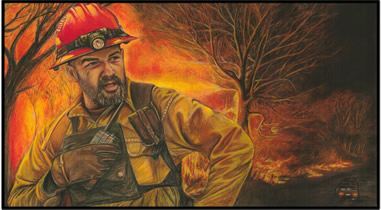Programs & Issues
Regional Fire Program |
Pacific Southwest Region Fire ManagementHelpful Resource LinksBefore the Fire:
During the Fire:After the Fire:Working with Wildfire
Ilustration by Miriam Morrill What We Do Before a WildfireThe U.S. Fish & Wildlife Service fire program works with biological staff and partners to protect and enhance habitats for fish, wildlife and plants on National Wildlife Refuges and National Fish Hatcheries. Prescribed fire and mechanical treatments are used as tools to improve habitat conditions as well reduce hazardous levels of vegetation which pose a fire risk to communities and infrastructure. Pre-fire project objectives emphasize firefighter and public safety, reducing fire spread and intensity, reducing wildfire smoke impacts, eliminating invasive plant species and often restoring fire's natural role in the ecosystem. We also provide assistance and support to neighbors and landscape partners in their fire management programs. The region treats an average of 35,000 acres a year of habitat and hazardous fuels. Half of the treatments occur in the wildland-urban interface. What We Do During a WildfireThe region has 47 permanent fire employees trained by national interagency fire standards; five Regional Program Managers, five Zone Fire Management Officers and the remaining are a mix of Assistant Fire Management Officers, Prescribed Fire Specialists, Engine Captains and firefighter crew members. Our firefighters suppress unwanted and unmanaged wildfires on refuge lands and participate on interagency incident management teams in support of local, national and international fire response efforts. All fire operations emphasize firefighter and public safety first. On average there are 60 wildfires a year that occur on refuge lands in the region burning an approximate 15,000 acres each year. What We Do After a WildfireAfter a wildfire, a burned area assessment will be made to determine if emergency stabilization and rehabilitation actions are needed. Specialized interagency teams (Burned Area Emergency Response Teams) can be called in to assess impacts and develop plans and recommendations for wildfire impacts on federal lands. Initially after a wildfire, the incident management team will work with the land management agency to rehabilitate a number of areas impacted by fire suppression actions. The BAER Team is brought in to assess and stabilize larger scale impacts and longer term rehabilitation efforts such as invasive species control and erosion control. |
California, Nevada and Klamath Basin
Last updated:
April 30, 2009

